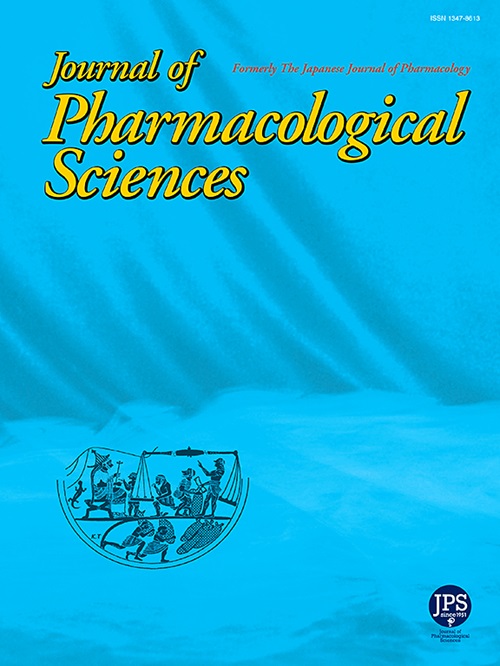凝血酶诱导的犬尿氨酸3-单加氧酶引起犬尿氨酸途径的变化,导致小鼠脑出血模型的神经功能缺损。
IF 2.9
3区 医学
Q2 PHARMACOLOGY & PHARMACY
引用次数: 0
摘要
本研究旨在探讨脑出血(ICH)后犬尿氨酸通路的变化及其对脑出血损伤的影响。凝血酶暴露于原代大鼠小胶质细胞培养后,犬尿氨酸3-单加氧酶(KMO) mRNA水平升高,而p38 MAPK抑制剂可减弱这种升高。凝血酶也使KMO蛋白水平升高。在培养基中,n -甲基-d-天冬氨酸受体(NMDAR)激动剂喹啉酸(QUIN)与其拮抗剂犬尿酸(KYNA)的比例增加。KMO抑制剂Ro61-8048阻断了QUIN/KYNA比值的增加。在小鼠ICH模型中,KMO mRNA表达增加。免疫组织化学染色显示KMO增加与神经元、小胶质细胞和星形胶质细胞共定位。脑出血后,QUIN/KYNA比值升高,但被Ro61-8048或氯膦酸钠(一种小胶质细胞毒素)阻断。Ro61-8048改善脑水肿;然而,这种作用被一种NMDAR拮抗剂MK-801所掩盖。Ro61-8048可防止血肿周围区域的神经元丢失,并可修复神经功能缺损。综上所述,凝血酶诱导的小胶质细胞KMO的改变以及犬尿氨酸途径的中间代谢物似乎在脑出血后神经元损伤中发挥了重要作用。本文章由计算机程序翻译,如有差异,请以英文原文为准。
Thrombin-induced kynurenine 3-monooxygenase causes variations in the kynurenine pathway, leading to neurological deficits in a murine intracerebral hemorrhage model
The purpose of the present study is to investigate changes in the kynurenine pathway after intracerebral hemorrhage (ICH) and its effects on ICH-induced injury. The exposure of a primary rat microglial culture to thrombin increased the mRNA level of kynurenine 3-monooxygenase (KMO), and this increase was attenuated by a p38 MAPK inhibitor. Thrombin also increased the protein level of KMO. In the cultured medium, the ratio of quinolinic acid (QUIN), an N-methyl-d-aspartate receptor (NMDAR) agonist, to kynurenic acid (KYNA), its antagonist, increased. The increase in the QUIN/KYNA ratio was blocked by Ro61-8048, a KMO inhibitor. The mRNA expression of KMO increased in an in vivo murine ICH model. Immunohistochemical staining showed that increased KMO co-localized with neurons, microglia, and astrocytes. The QUIN/KYNA ratio increased after ICH but was blocked by Ro61-8048 or clodronate, a microglia toxin. Ro61-8048 ameliorated brain edema; however, this effect was masked by MK-801, an NMDAR antagonist. Ro61-8048 protected against neuron loss in the perihematomal region and repaired neurological deficits assessed using the corner turn and pole tests. In conclusion, thrombin-induced changes in KMO in microglia mainly and intermediary metabolites of the kynurenine pathway appear to play crucial roles in neuronal injury after ICH.
求助全文
通过发布文献求助,成功后即可免费获取论文全文。
去求助
来源期刊
CiteScore
6.20
自引率
2.90%
发文量
104
审稿时长
31 days
期刊介绍:
Journal of Pharmacological Sciences (JPS) is an international open access journal intended for the advancement of pharmacological sciences in the world. The Journal welcomes submissions in all fields of experimental and clinical pharmacology, including neuroscience, and biochemical, cellular, and molecular pharmacology for publication as Reviews, Full Papers or Short Communications. Short Communications are short research article intended to provide novel and exciting pharmacological findings. Manuscripts concerning descriptive case reports, pharmacokinetic and pharmacodynamic studies without pharmacological mechanism and dose-response determinations are not acceptable and will be rejected without peer review. The ethnopharmacological studies are also out of the scope of this journal. Furthermore, JPS does not publish work on the actions of biological extracts unknown chemical composition.

 求助内容:
求助内容: 应助结果提醒方式:
应助结果提醒方式:


